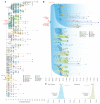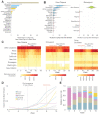This is a preprint.
Emergence of an early SARS-CoV-2 epidemic in the United States
- PMID: 33564781
- PMCID: PMC7872376
- DOI: 10.1101/2021.02.05.21251235
Emergence of an early SARS-CoV-2 epidemic in the United States
Update in
-
Emergence of an early SARS-CoV-2 epidemic in the United States.Cell. 2021 Sep 16;184(19):4939-4952.e15. doi: 10.1016/j.cell.2021.07.030. Epub 2021 Jul 27. Cell. 2021. PMID: 34508652 Free PMC article.
Abstract
The emergence of the early COVID-19 epidemic in the United States (U.S.) went largely undetected, due to a lack of adequate testing and mitigation efforts. The city of New Orleans, Louisiana experienced one of the earliest and fastest accelerating outbreaks, coinciding with the annual Mardi Gras festival, which went ahead without precautions. To gain insight into the emergence of SARS-CoV-2 in the U.S. and how large, crowded events may have accelerated early transmission, we sequenced SARS-CoV-2 genomes during the first wave of the COVID-19 epidemic in Louisiana. We show that SARS-CoV-2 in Louisiana initially had limited sequence diversity compared to other U.S. states, and that one successful introduction of SARS-CoV-2 led to almost all of the early SARS-CoV-2 transmission in Louisiana. By analyzing mobility and genomic data, we show that SARS-CoV-2 was already present in New Orleans before Mardi Gras and that the festival dramatically accelerated transmission, eventually leading to secondary localized COVID-19 epidemics throughout the Southern U.S.. Our study provides an understanding of how superspreading during large-scale events played a key role during the early outbreak in the U.S. and can greatly accelerate COVID-19 epidemics on a local and regional scale.
Figures





References
-
- First Travel-related Case of 2019 Novel Coronavirus Detected in United States. https://www.cdc.gov/media/releases/2020/p0121-novel-coronavirus-travel-c... (2020).
Publication types
Grants and funding
LinkOut - more resources
Full Text Sources
Other Literature Sources
Miscellaneous
